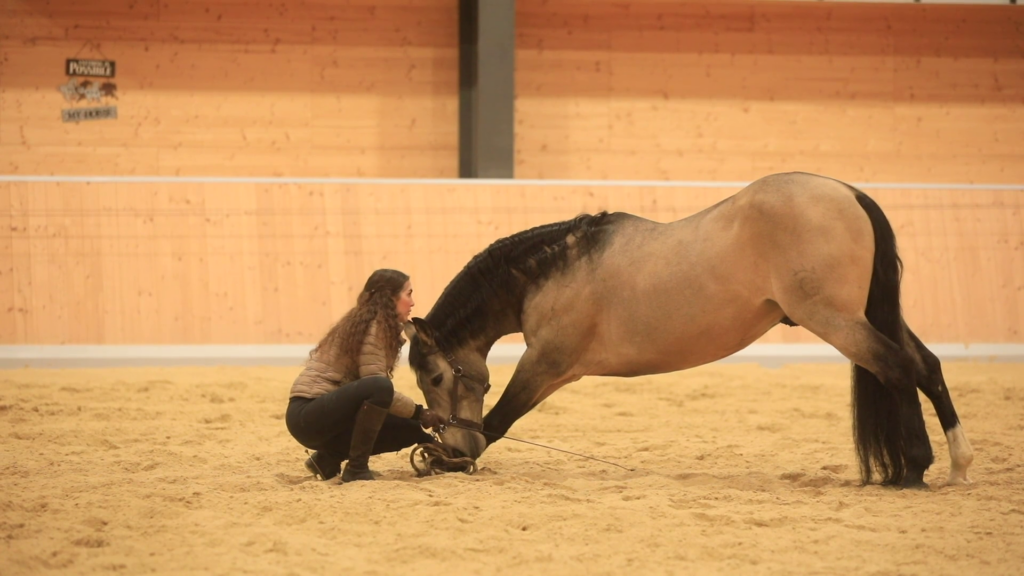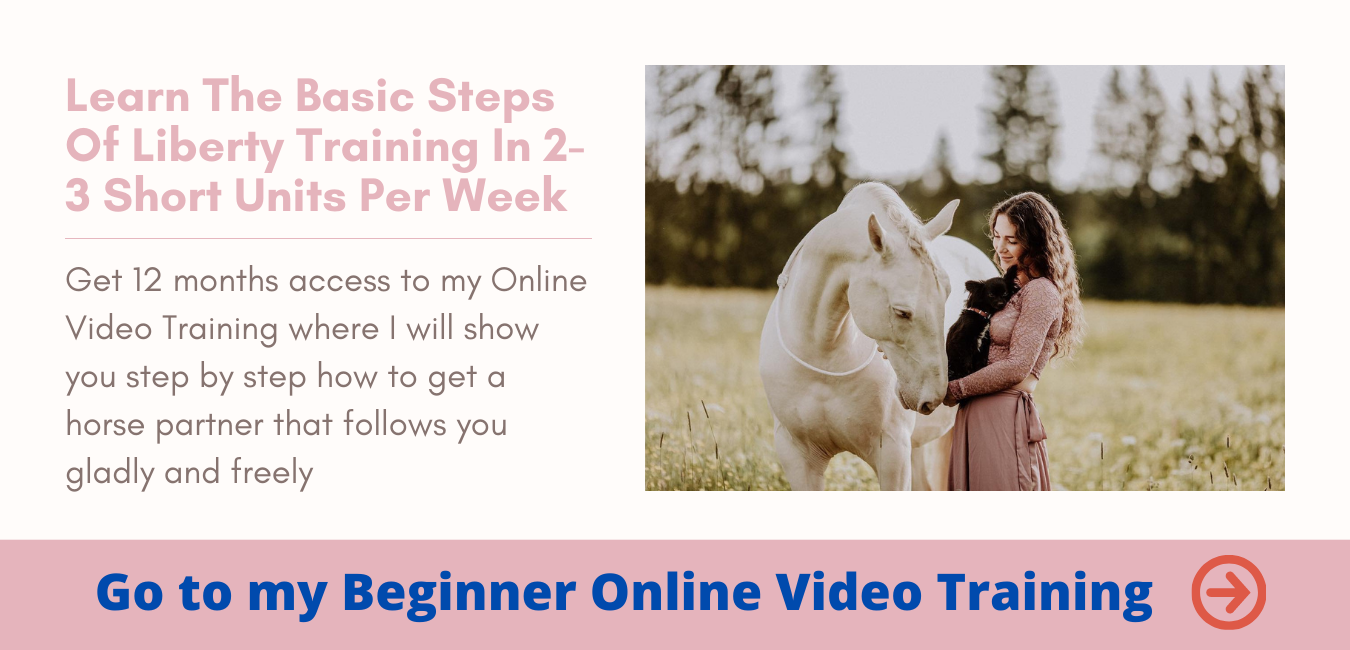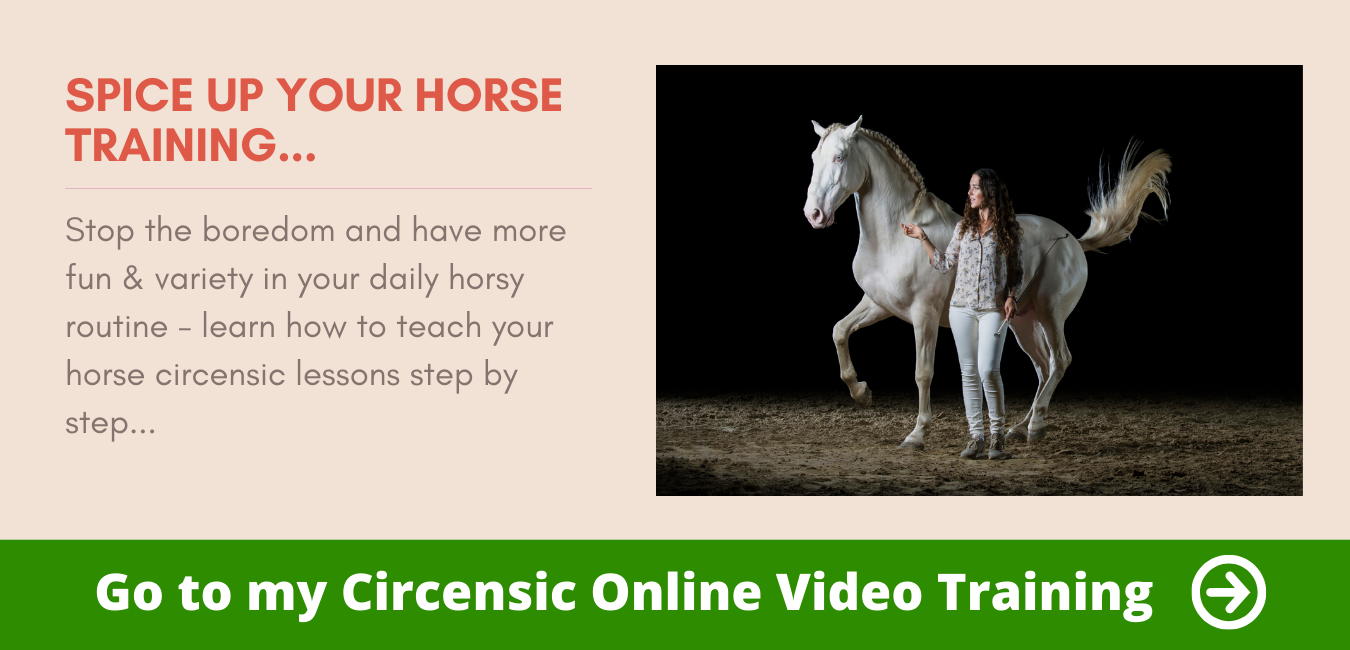Today we will focus on the “stretching” – which you can use wonderfully as a preliminary exercise for the compliment, but which of course also has a right to exist as a lesson in its own right!
What does the stretching look like?
Logically, the horse does not spread its hind legs as far as possible, as we would do.
Although that would certainly look funny, wouldn’t it 😉
I call the stretching in horses the exercise of placing the front and hind legs as far apart from each other as possible – and in the best case still stretching correctly.
This means that the horse gradually moves its front legs further and further forward.
The trick is for the horse to shift its weight to the hindquarters and to put its head down towards the ground between the front legs.
This stretches the entire upper line.
At the same time, balance and coordination are promoted.
How to teach the stretching to your horse
The stretching is actually much easier to teach than the Spanish walk – the basic idea is the same:
You touch your horse’s leg with the whip and he moves this leg forward a bit.
It is important that for each exercise you choose a specific point to touch the leg, which must always remain the same.
If possible, the points should be relatively far apart, because then your horse will not get confused.
Of course, it also makes sense to link the touching with the whip to a certain voice signal, so that the whip becomes superfluous in the end.
That’s why I touch my horses very far down on the leg for the splits, below the fetlock, so to speak.
In addition, I don’t stand in front of my horse (as is sometimes the case with the Spanish walk) but directly next to it, so that my horse has a clear path to the front.
From this position, I can later shift my horse’s weight backwards more easily and make him stretch his topline.
I now stand next to my horse at about the shoulder and touch the leg.
If your horse does not yet know the “right answer”, you immediately reward him with a vocal praise and that you stop touching him as soon as he lifts or moves his leg.
Once your horse understands that you want him to move his leg, start praising him only when he moves his leg a little further forward.
Many horses try out what you want them to do quite hectically at this stage.
However, you should always remain calm – because that is basically half the battle!
If your horse does not move his leg at all, do not increase the pressure with which you touch your horse.
Instead, be “the annoying fly” that your horse wants to chase away at some point.
As soon as he moves just a millimetre with the right leg, stop immediately and praise your horse.
And be patient! There is hardly anything more important in horse training 😉
Depending on how quickly your horse learns or how good his idea is of what you want him to do (inner images help immensely here – even just with your execution!) you can practise directly on both front legs.
However, do not overload your horse if he is struggling and otherwise postpone the second leg until the next day.
If your horse now moves both front legs forward independently of each other in response to your touching, you touch both legs alternately and let your horse shimmy further and further forward.
Remember in the beginning that this really needs practice and don’t overdo it, because your horse should have at least as much fun as you do 😉
If your horse is now standing with its front legs a little away from its hind legs, you can lure it with a treat with its head between its legs.
Make sure that the neck remains really long and lure as far as possible towards the ground, otherwise your horse can quickly lose its balance.
In the beginning, your horse may only quickly grab the treat in this position and then stand more closed again.
This is not bad at all!
As I said, it takes practice to hold this position and the stretching can – depending on how firm your horse’s muscles are – be a little uncomfortable for your horse at the beginning, just as stretching can be uncomfortable for us.
Therefore, give yourself and your horse time and only increase the stretch slowly!
By the way, for the compliment you have now worked well ahead even without the stretch into the depth, if your horse stands with his front and hind legs quite far apart.
From this position you can now start to lift one of your horse’s front legs as described in the last blog post and loosen or cradle it into the compliment.
Tip: If you want to establish the stretching as a separate exercise, the spreading of the legs including the stretching should be well done before you start with the compliment.
Many horses find the compliment much easier in the long run and like to “cheat” their way out of the stretching.
You will therefore be doing yourself and your horse a favour if you first clearly separate the exercises so that the horse can really tell them apart.
IMPORTANT: Always practise the stretching or other exercises such as the compliment with a warmed-up horse, otherwise it can quickly injure itself.
Mental exercise – the key to a relaxed horse?
I myself am a big fan of incorporating such “circus lessons” – which ideally also have a gymnastic value – into everyday training, even if it is only for a few minutes after a relaxed riding lesson or a unit of free dressage!
Because when your horse learns something new, his head is challenged in a completely different way than when recalling old, familiar lessons.
And that usually takes a lot more out of our horses than pure physical work.
Maybe you were already physically exhausted, but your head didn’t give you a break?
There always needs to be a balance between physical workload – for us and also for our horses, even if they don’t have to struggle with our human mental carousel 😉
An inwardly balanced horse that is at rest and has found its place – in your herd of two, but of course also in the rest of the time, is an invaluable partner with whom almost anything becomes possible!
So it’s worth thinking about what makes your horse happy.
And to see exactly when he becomes particularly relaxed and balanced 😉
Because it’s always worth looking!
After all, our horses tell us so much!
But they are usually very quiet – and we have to be able to be quiet ourselves and give our horses the space to do so.
This is what trust and respect mean on both sides – and what makes the trust grow with each new day.
No matter if I make progress or if there are setbacks.
In this sense, have fun and a great time with your horse. Even if it is short at the moment.
Even if you can’t see your horse at all:
Plan your training sessions now!
This is a lot of fun and can be incredibly valuable – if you still listen to your horse and if necessary change your plan in favour of your horse 😉
[su_youtube url=”https://youtu.be/R_kn-JeRnt4″]
All the best
Your Kenzie




